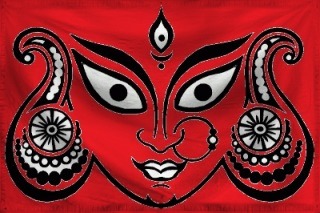6
The Matriarchy of Shaktirajya - Culture
CultureI. East is East and West is West The British and East Indian Roots of Shaktirajya
Shaktirajya being a multi-ethnic realm comprising a confederation of villages, has a varied and rich culture. A goodly portion of the population comes from the Indian subcontinent, bringing with them the notion of panchayati raj or village council rule. The country contains many examples of Indo-Persianate architecture introduced by Punjabi immigrants. Along with this, there are examples of the erroneously named "Indo-Saracenic" or the more aptly named Anglo-Indian style of the British architect Sir Edwin Landseer Lutyens. Shaktirajya takes many elements of its culture from the cultural exchange between the British and the Indians during the period of British settlement in India beginning with the arrival of the British East India Company in the 18th century. While in the past, back in England, marriages between British soldier-merchants and Indian women were annulled by the stuffy Victorian government, such unions are celebrated and encouraged in Shaktirajya. A unique, classic Anglo-Indian culture has emerged in parts of Shaktirajya and the works of Rudyard Kipling and other classic Anglo-Indians are widely read. Not only does there exist a community of ethnic English settlers from India, but also a community of Anglo-Indians born from the union of English and native East Indian settlers. This community has largely made its home along the electric railroad tracks and world-class transportation depots of Shaktirajya as their parents were traditionally employed by Shaktirajya Railways, a company started by British settlers. Nowadays, Shaktirajya Railways employs a massive number of Shaktirajya's citizens who are paid handsomely and given many benefits by the administration of the country. Due to the great influence of Tantric Hinduism present in the land, there are several classical Hindu temples with tantric engravings depicting nature spirits, yakshis and dakinis.
Indo-Persianate Architecture

Anglo-Indian Architecture of Sir Edwin Lutyens

Tantric Hindu Temple Architecture


II. Shaktirajya's Mediterranean Heritage
Shaktirajya has a sizable population of ethnic Greeks, Italians and Sicilians, as well as a massive number of people who see the classical Mediterranean as the foundation of their intellectual heritage. Due to this, many communities in Shaktirajya have built Greco-Roman, and Hellenistic buildings as homes, as administrative structures, and as temples. As the Alexandrian empire was a cosmopolitan entity linking many different territories and ethnic groups under the Greek language and Hellenic (Greek) culture, Alexander the Great, his era, and his legacy is greatly favored by the worldly, cultured citizenry of Shaktirajya.
Temple of the goddess Artemis-Diana in Shaktirajya's Capital, Civitas Matris Magnae, (Latin. "City of the Great Mother")

Shaktirajya's Temple of All the Gods

The Interior of the Temple

The Temple of Athena Parthenos

III. Germans and Scandinavians in Shaktirajya
When it was announced that a new sovereign nation of goddess worshipers was going to be created, great numbers of Germans and Scandinavians practicing their ancient pre-Christian religion came from far and wide to settle in the new land. They were no doubt inspired by the voluminous tomes about linguistics, folk-tales, and ancient mythology written by the Brothers Grimm. The arrival of Germanic Northern Europeans led to the construction of a gigantic, state-of-the-art Autobahn which revolutionized the nature of travel in Shaktirajya. The futuristic, highly efficient superhighway is the envy of all the world. German and Scandinavian immigrants to Shaktirajya brought with them their bon-fire festivals including Walpurgisnacht, a night dedicated to an old Germanic goddess, and celebrated on mountaintops, accompanied by great shouts, feasts and merrymaking. These settlers from the cold, white, North brought with them their love of beer and mead, a fermented honey-wine. The community constructed various great taverns and beer-halls after the style of their native lands. High numbers of German settlers, along with prolific works on history, culture, and folktales by German scholars, led to the adoption of German alongside Sanskrit as Shaktirajya's co-official language.
A German Beer Hall in Neu Elsass, Shaktirajya

Germans and Scandos enjoy a cold brew among friends at the Riksmal Brau-Hof, Neu Lothringen

Things often get wild during Shaktirajya's annual Oktoberfest

After first saluting the goddess Freyja and Her consort Ottar, the crowd chants "Wir wollen abgefukt werden!" (German. "We wanna get f***'ed up!")

Shaktirajya's Walpurgisnacht or May Day Celebrations

An Ethnic German citizen of Shaktirajya being f***ing Awesome

Shaktirajya's German-style Autobahn is at the forefront of high-speed Travel

The Brothers Grimm were world class German scholars and inspired many immigrants to come to Shaktirajya

Das Vollig-geil Festspielhaus: Shaktirajya's Wagnerian Opera house













